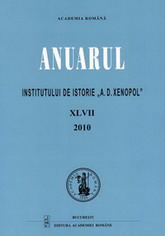Despre sovietizarea arhitecturii româneşti (1947-1955)
About the Sovietisation of Romanian Architecture (1947-1955)
Author(s): Gabriel CatalanSubject(s): History
Published by: Editura Academiei Române
Keywords: architecture; socialist realism; propaganda; Soviet model
Summary/Abstract: The Stalinist transformation of the Romanian culture and society was the consequence of the military Russian occupation of the country and of the political actions of the new government leaded by Romanian Communist Party, who imposed the Soviet model by force, terror and propaganda. Since 1947/1948 the architecture are under the control of the economic and agitation and propaganda sections of the Central Committee of the Romanian Communist Party. Also, the communist government had a department of architecture, constructions and urbanism. The socialist realism, the architectural style (for example, the block-buildings of Jiului Valley, Medgidia, Braşov and Bucharest, the bridges, the gas pipe Agnita-Botorca, the tunnels and railways like Bumbeşti-Livezeni, the factories, the Danube-Black Sea Channel, the National Theatre or Spark/Press House), the soviet counsellors and specialists, the anti-cosmopolite campaign, the lectures, textbooks and published works, the design offices, town planning institutes and branch associations, the exhibitions and projects, all that were presented as phenomenal achievements of the new era, according to the Soviet model. Very few architects are suffered or died in the jail (George Matei Cantacuzino, Ioan D. Enescu), many others choose to adopt a wait and see policy and finally are marginalized (Petre Antonescu, Ştefan Balş, Constantin Iotzu, Constantin Jora), some make the choice to go in the exile (Haralamb Georgescu is the best example) but the absolute majority is formed of the Party activists and even members of the Nomenklatura, many of them with Jewish origin (Pompiliu Alexandru Macovei, Gustav Gusti, Micu Goldenberg, alias Horia Maicu, Nicolae Bădescu, Octav Doicescu, Ascanio Damian, Harry Stern, Dorian Hardt, Marcel Locar, Grigore Ionescu, Cezar Lăzărescu, Mircea Alifanti). Like all the arts and sciences, under communism, architecture knows the same totalitarians practices and values.
Journal: Anuarul Institutului de Istorie »A.D. Xenopol« - Iaşi
- Issue Year: XLVII/2010
- Issue No: 47
- Page Range: 107-118
- Page Count: 11
- Language: Romanian

